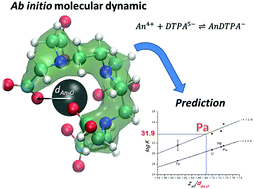On the use of speciation techniques and ab initio modelling to understand tetravalent actinide behavior in a biological medium: AnIVDTPA case
Abstract
In the case of an accidental nuclear event, contamination of human bodies by actinide elements may occur. Such elements have the particularity to exhibit both radiological and chemical toxicities that may induce severe damages at several levels, depending on the biokinetics of the element. In order to eliminate the actinide elements before they are stored in target organs (liver, kidneys, or bone, depending on the element), sequestering agents must be quickly injected. However, to date, there is still no ideal sequestering agent, despite the recent interest in this topic due to contamination concerns. DTPA (diethylene triamine pentaacetic acid) is currently generating interest for the development of oral or alternative self-administrable forms. Although biokinetics data are mostly available, molecular scale characterization of actinide-DTPA complexes is still scarce. Nevertheless, strong interest is growing in the characterization of AnIVDTPA− complexes at the molecular level because this opens the way for predicting the stability constants of unknown systems or even for developing new analytical strategies aimed at better and more selective decorporation. For this purpose, Extended X-ray Absorption Fine Structure (EXAFS) and Ab Initio Molecular Dynamics (AIMD) investigations were undertaken and compared with capillary electrophoresis (CE) used in a very unusual way. Indeed, it is commonly believed that CE is incapable of extracting structural information. In capillary electrophoresis, the electrophoretic mobility of an ion is a function of its charge and size. Despite very similar  ratios, partial separations between AnIVDTPA− species (AnIV = Th, U, Np, Pu) were obtained. A linear relationship between the electrophoretic mobility and the actinide – oxygen distance calculated by AIMD was evidenced. As an example, the interpolated U–O distances in UIVDTPA− from CE-ICPMS experiments, EXAFS, AIMD, and the relationship between the stability constants and the ratio z/dAn–O, are all in agreement. This results in the capability to evaluate the stability constants for the formation of PaIVDTPA−, AmIVDTPA− or BkIVDTPA−.
ratios, partial separations between AnIVDTPA− species (AnIV = Th, U, Np, Pu) were obtained. A linear relationship between the electrophoretic mobility and the actinide – oxygen distance calculated by AIMD was evidenced. As an example, the interpolated U–O distances in UIVDTPA− from CE-ICPMS experiments, EXAFS, AIMD, and the relationship between the stability constants and the ratio z/dAn–O, are all in agreement. This results in the capability to evaluate the stability constants for the formation of PaIVDTPA−, AmIVDTPA− or BkIVDTPA−.


 Please wait while we load your content...
Please wait while we load your content...